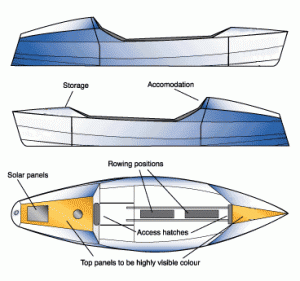|
Woodvale Pair
 Woodvale pairs rowboat is the most commonly used ocean rowboat. In 1995, boat designer Phillip Morrison created plans for a boat ideally suited for rowing across Oceans. It is capacious enough to shelter two people and hold several months of provisions, is lightweight, self-righting and shaped to move easily through turbulent waters.
The vessel is designed to be made from plywood with epoxy joinery, materials which are lightweight, relatively inexpensive, and easy to work with. Ballast for the rowboat is provided with freshwater tanks and there are two rowing stations. Crew accommodation is provided in an aft cabin six feet in length and about three feet maximum height. The boat is composed of 14 independently sealed compartments which prevents the entire boat from filling if it is holed.
This well-designed boat has become the most common boat used in ocean rowing. Plans and kits can be purchased for the homebuilder, or a growing second-hand market offers a variety of Philip-Morrison-designed boats for sale.
For a home-builder, the expense in constructing this vessel is not the basic hull and decks, but the accompanying hardware. Marine equipment is expensive and the cost of hatches, stainless steel fittings, custom-built pulpits, etc adds up quickly. Depending on how much work is contracted out, it can cost $50,000-$100,000 to build a fully equipped ocean rowboat.
It is generally cheaper to purchase a second-hand vessel with prices ranging from $20,000 to $50,000. |